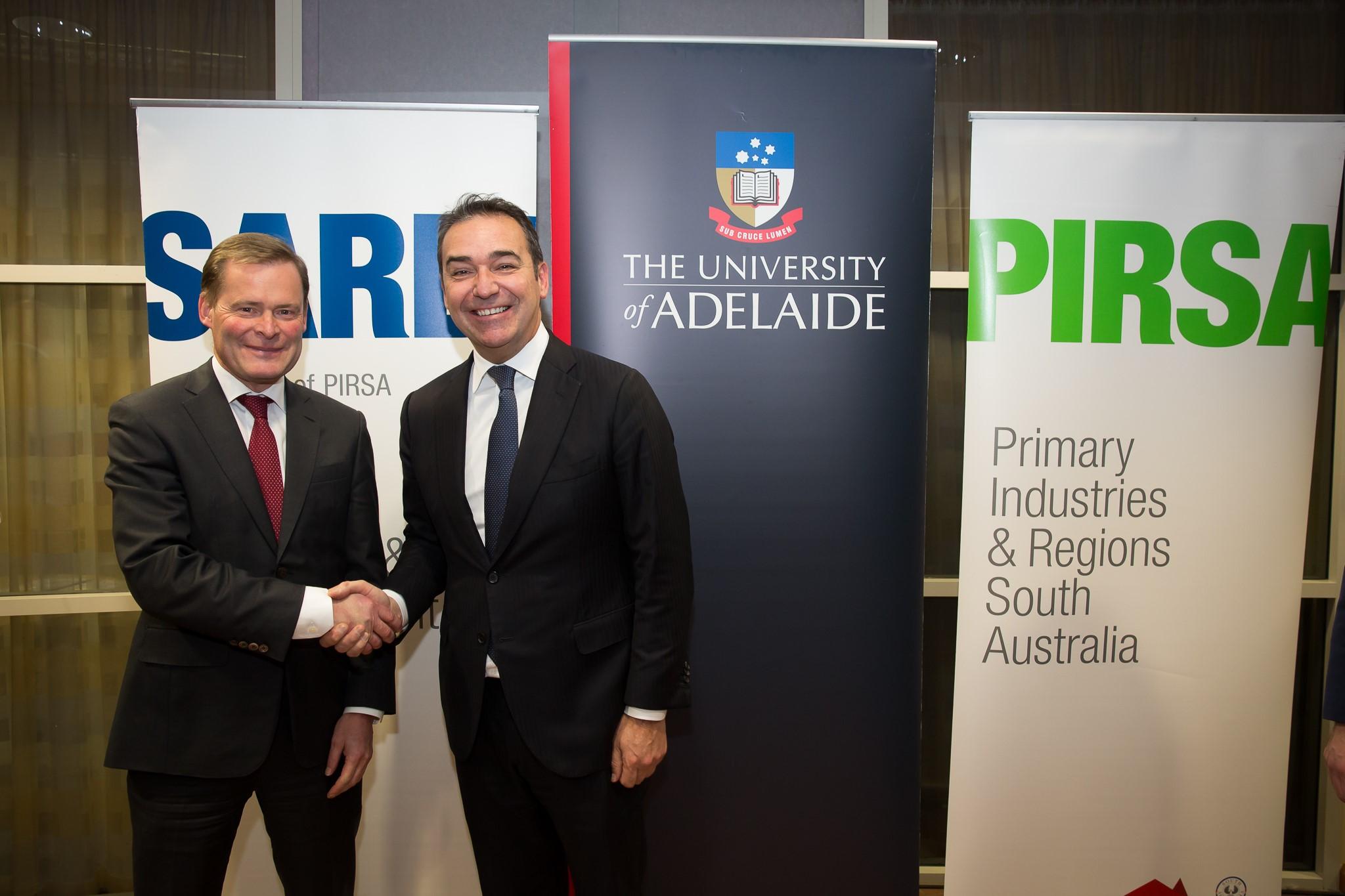Research giants team up to boost primary industries sector
The Marshall Liberal Government and University of Adelaide have officially launched a significant partnership to attract greater investment into South Australia and deliver greater economic benefits to the state’s primary industries sector.
Through the partnership, launched at the University’s Waite campus, the University of Adelaide and the State Government, through Primary Industries and Regions SA (PIRSA)’s research division, the South Australian Research and Development Institute (SARDI), will utilise each other’s strengths to generate high-value outcomes, including potential for export opportunities, and to attract greater external research funding.

University of Adelaide Vice-Chancellor Professor Peter Rathjen and South Australian Premier Steven Marshall officially launch the new partnership
Collaborative research will expand to embrace expertise in areas such as engineering, mathematics, computer science, big data, and machine learning, for the application of new technologies.
Initial research partnerships include a five-year, multi-partner $4.5 million research project to understand the drivers of terroir in the Barossa Valley, and a project developing herbicide-tolerant pulses, with herbicide-tolerant faba beans.
The University of Adelaide’s Vice Chancellor, Professor Peter Rathjen, said the partnership will provide ongoing benefits for South Australia.
“This new partnership between the University and PIRSA’s research division SARDI is a wonderful example of the kinds of synergistic relationships that will drive discovery and innovation, yielding benefits for our staff and students, for agricultural industries, for farmers, and for the economy,” said Professor Rathjen.
“For decades, the University of Adelaide has made a profound impact on Australia's multi-billion-dollar agriculture, food and wine sectors. This new partnership will help us to grow our research capability in these fields.”
Minister for Primary Industries and Regional Development Tim Whetstone said the partnership is expected to generate high-value outcomes for South Australia’s primary industries.
“South Australia’s agriculture, food and beverage, fisheries and forestry industries play a vital part in growing the State’s economy, and continuing to strengthen research and development through these industries is a key driver behind this partnership,” said Minister Whetstone.
“The partnership will foster closer relationships between industry and researchers, and through sharing our expertise and capability we can achieve positive outcomes for industry, and meet the goals of the Government’s growth agenda, designed to lift the state’s competitiveness and attract greater investment into our primary industries.
“It will also encourage further exploration in developing and utilising AgTech, which is critical to assist researchers and growers alike to overcome challenges and improve efficiency in food and fibre production for the future,” Mr Whetstone said.
SARDI researchers and facilities have been co-located at the University of Adelaide’s Waite and Roseworthy campuses for decades.
“While there has been much cooperation between us, our new partnership deepens the relationship and is in keeping with the University’s strategic industry engagement priority for agrifood and wine, as outlined in our new strategic plan, Future Making,” said Professor Mike Brooks, Deputy Vice-Chancellor (Research), University of Adelaide.
“By combining our expertise and research efforts, we aim to confront the big issues faced by our primary producers, and the results will be felt from the laboratory right through to the food people eat.”
PIRSA’s Executive Director, SARDI, Dr Peter Appleford said that he welcomed the opportunities the partnership will bring.
“PIRSA’s researchers across the state will benefit from the leverage this partnership with the University offers,” said Dr Appleford.
“Our focus is on delivering innovative world-leading applied research so South Australia’s primary industries can be internationally competitive, and working together with the University can only enhance our capability in this space.”
About this article
Written by Dr Greg Guerin, this article was republished from Biodiversity Revolution: Thoughts from the vanguard of biodiversity research. View the original article.
It is a plain language summary of the paper published in the Applied Vegetation Science.
